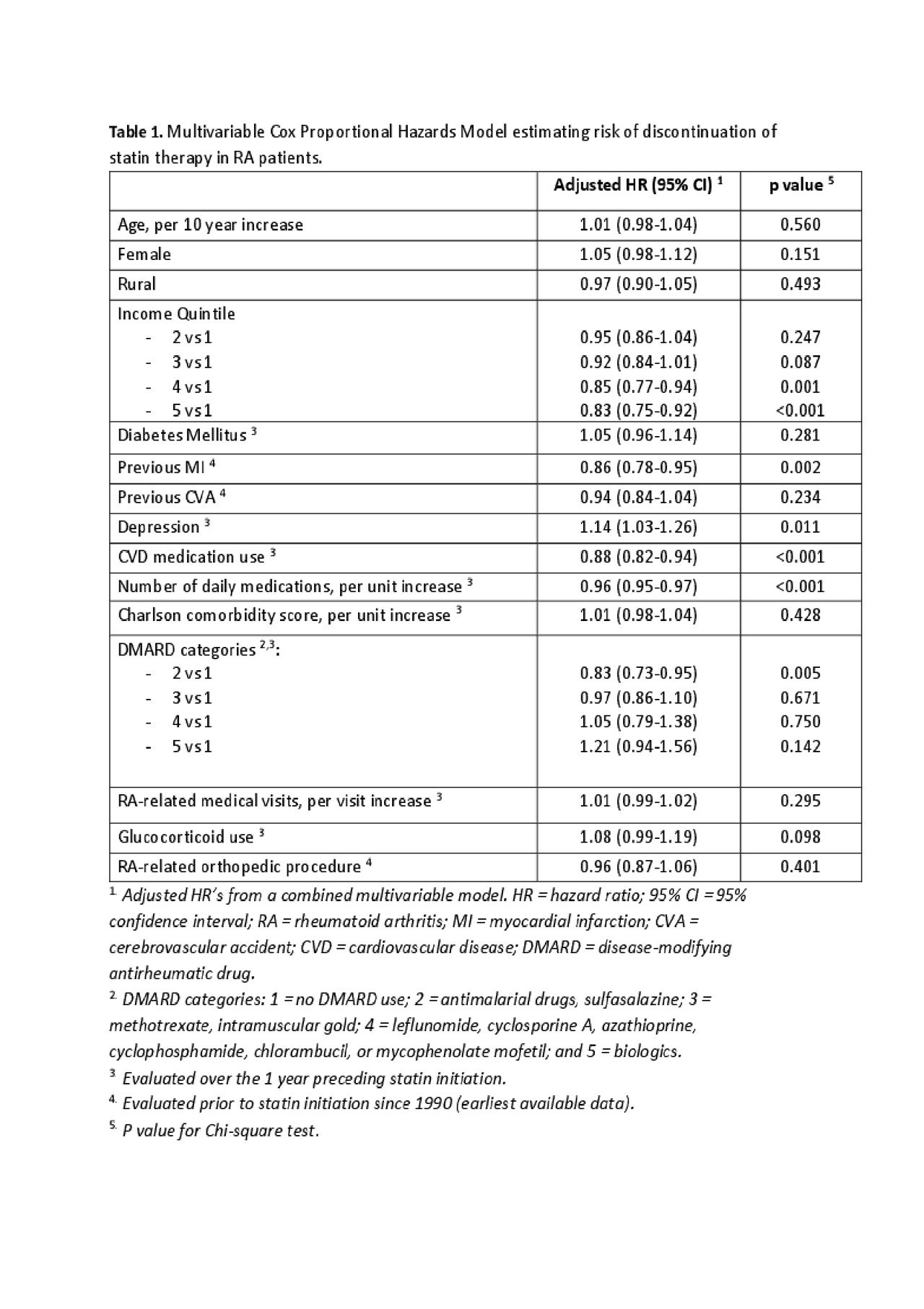Session Information
Date: Sunday, November 10, 2019
Title: 3S089: Health Services Research I: Clinical Perspectives (951–956)
Session Type: ACR/ARP Abstract Session
Session Time: 4:30PM-6:00PM
Background/Purpose: Cardiovascular diseases (CVD) are increased in RA and lead to premature mortality. Statins are effective at preventing incidence of, and mortality from, CVD; yet, adherence can be problematic. The objective of this study was to assess adherence to statin therapy in a population-based cohort of rheumatoid arthritis (RA) patients compared to the general population, and to identify the predictors of statin discontinuation in the RA cohort.
Methods: A population-based cohort study using administrative health data was conducted on all incident RA patients in the Province, identified using physician billing data and previously published criteria, and general population controls matched (2:1) on age, sex and calendar year. The study included all individuals who initiated a statin for the first time between January 1997 and December 2009, with follow-up until December 2014. Statin discontinuation was defined as a gap in medication dispensing of ≥4 months. The primary outcome was survival time from statin initiation until first discontinuation , and the secondary outcome was the proportion of days covered (PDC) of medication, calculated only during courses of active statin use (i.e., excluding periods of statin discontinuation), which represents the percentage of the time when a medication is taken as prescribed. A multivariable Cox proportional hazards models was used to identify the predictors of statin discontinuation in the RA sample only.
Results: The sample includes 4845 incident RA patients who were incident statin users, and 9204 individuals from the general population, providing 16728 and 34351 PY of follow-up, resp. 82.4% of the RA and 80.2% of the general population cohorts had at least one discontinuation; and 42.2% of RA and 40.2% of the general population permanently discontinued statin therapy during follow-up. Figure 1 shows that survival on statin (time to first statin discontinuation) was slightly lower for RA than general population (p < 0.001). Median survival was 2.29 years for RA patients and 2.64 years (for controls. Incidence rate of discontinuation was 23.87 per 100PY for RA and 21.48 per 100PY for the general population, yielding an incidence rate ratio (IRR) of 1.11; 95% CI, 1.07 – 1.16. Adherence [Mean (SD) PDC] during treatment courses was 92.9 (9.3)% in RA patients and 92.7 (9.4)% among controls. Significant predictors of statin discontinuation in RA included number of daily medications; use of CVD medications; previous MI; higher income; and depression (Table 1).
Conclusion: Findings from our population-based study indicate that RA patients and the general population both frequently discontinue statin therapy, but have high adherence during periods of statin use. Rates of statin discontinuation were slightly higher in RA patients, despite an increased risk of CVD. Risk of discontinuation was lower in RA patients with a higher number of daily meds, use of cardiovascular meds, prior MI, and higher income, and was higher in patients with depression. These results emphasize the importance of discussing adherence.

Table 1. Multivariable Cox Proportional Hazards Model estimating risk of discontinuation of statin therapy in RA patients
To cite this abstract in AMA style:
Hahn T, Sayre E, Goycochea-Robles M, Lacaille D. Adherence to Statin Therapy in Rheumatoid Arthritis Patients: A Population-Based Cohort Study [abstract]. Arthritis Rheumatol. 2019; 71 (suppl 10). https://acrabstracts.org/abstract/adherence-to-statin-therapy-in-rheumatoid-arthritis-patients-a-population-based-cohort-study/. Accessed .« Back to 2019 ACR/ARP Annual Meeting
ACR Meeting Abstracts - https://acrabstracts.org/abstract/adherence-to-statin-therapy-in-rheumatoid-arthritis-patients-a-population-based-cohort-study/

